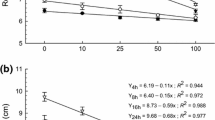Abstract
Brassica juncea L. eight-day-old seedlings treated with various concentrations (50–200 µM) of copper for 48 h accumulated Cu more in the roots than in leaves. Accumulation of copper resulted in more active lipid peroxidation and depletion of glutathione (GSH) pools in both roots and shoots, which was attributed to copper-induced additional oxidative stress. Activities of ascorbate peroxidase and superoxide dismutase were higher in both roots and shoots while catalase activity increased in leaves but remained unchanged in roots in response to copper accumulation. Changes in lipid peroxidation, GSH content, and antioxidant enzyme activities suggest that oxidative damage may be involved in copper toxicity.
Similar content being viewed by others
Abbreviations
- AP:
-
ascorbate peroxidase
- CAT:
-
catalase
- GSH:
-
reduced glutathione
- GSSG:
-
oxidized glutathione
- MDA:
-
malondialhehyde
- NBT:
-
nitro blue tetrazolium
- ROS:
-
reactive oxygen species
- SOD:
-
superoxide dismutase
REFERENCES
Halliwell, B. and Gutteridge, J.M.C., Oxygen Toxicity, Oxygen Radicals, Transition Metals and Disease, Biochem. J., 1984, vol. 219, pp. 1–14.
Wolff, S.P., Gamer, A., and Dean, R.T., Free Radicals, Lipids and Protein Degradation, Trends Biochem. Sci., 1986, vol. 11, pp. 27–31.
Salt, D.E., Blaylock, M., Kumar, N.P., Dushenkov, V., Ensley, B.D., Chet, I., and Raskin, I., Phytoextraction: A Novel Strategy for the Removal of Toxic Metals from the Environment Using Plants, Biotechnology, 1995, vol. 13, pp. 468–474.
Kumar, P.B.A.N., Dushenko, V., Motto, H., and Raskin, I., Phytoextraction: The Use of Plants to Remove Heavy Metals from Soils, Environ. Sci. Technol., 1995, vol. 29, pp. 1232–1238.
Heath, R.L. and Packer, L., Photoperoxidation in Isolated Chloroplast. Kinetics and Stoichiometry of Fatty Acids Peroxidation, Arch. Biochem. Biophys., 1968, vol. 125, pp. 189–198.
Del Longo, O.T., Gonzalez, C.A., Pastori, G.M., and Trippi, V.S., Antioxidant Defences under Hyperoxygenic and Hyperosmotic Conditions in Leaves of Two Lines of Maize with Differential Sensitivity to Drought, Plant Cell Physiol., 1993, vol. 34, pp. 1023–1028.
Hissin, P.J. and Hilf, R.A., Fluorimetric Method for the Determination of Oxidized and Reduced Glutathione in Tissues, Anal. Biochem., 1976, vol. 74, pp. 214–226.
Lowry, O.H., Rosebrough, N.J., Farr, A.L., and Randall, R.J., Protein Measurement with the Folin Phenol Reagent, J. Biol. Chem., 1951, vol. 193, pp. 265–275.
Mittler, R. and Zilinskas, B.A., Detection of Ascorbate Peroxidase Activity in Native Gels by Inhibition of the Ascorbate-Dependent Reduction of Nitroblue Tetrazolium, Anal. Biochem., 1993, vol. 212, pp. 540–546.
Aebi, H., Catalases, in Methods of Enzymatic Analysis III, 1971, pp. 273–286.
Beauchamp, C. and Fridovich, I., Superoxide Dismutase: Improved Assays and an Assay Applicable to Acrylamide Gels, Anal. Biochem., 1971, vol. 44, pp. 276–287.
Stohs, S. and Bagchi, D., Oxidative Mechanisms in the Toxicity of Metal Ions, Free Rad. Biol. Med., 1995, vol. 18, pp. 321–336.
Dietz, K.J., Baier, M., and Krämer, U., Free Radicals and Reactive Oxygen Species as Mediators of Heavy Metal Toxicity in Plants, Heavy Metal Sress in Plants: From Molecules to Ecosystems, Prasad, M.N.V. and Hagemeyer, J., Eds., Berlin: Springer-Verlag, 1999, pp. 73–98.
Devi, S.R. and Prasad, M.N.V., Membrane Lipid Alterations in Heavy Metal Exposed Plants, Heavy Metal Sress in Plants: From Biomolecules to Ecosystems, Prasad, M.N.V. and Hagemeyer, J., Ed., Berlin: Springer-Verlag, 2004, pp. 127–145.
Jain, S.K., The Accumulation of Malonyldialdehyde, a Product of Fatty Acid Peroxidation, Can Disturb Aminophospholipid Organization in the Membrane Bilayer of Human Erythrocytes, J. Biol. Chem., 1984, vol. 259, pp. 3391–3394.
De Vos, C.H.R., Bookum, W.M.T., Vooijs, R., Schat, H., and de Kok, L.J., Effects of Cu on Fatty Acid Composition and Peroxidation of Lipids in Roots of Copper Tolerant and Sensitive Silene cucubalus, Plant Physiol. Biochem., 1993, vol. 31, pp. 151–158.
Luna, C.M., Gonzalez, C.A., and Trippi, V.S., Oxidative Damage Caused by an Excess of Copper in Oat Leaves, Plant Cell Physiol., 1994, vol. 35, pp. 11–15.
Larson, R.A., The Antioxidants of Higher Plants, Phytochemistry, 1988, vol. 27, pp. 969–978.
Alsher, R.G. and Hess, J.L., Antioxidants in Higher Plants, Boca Raton: CRC, 1993.
Allen, R.D., Dissection of Oxidative Stress Tolerance Using Transgenic Plants, Plant Physiol., 1995, vol. 107, pp. 1049–1054.
Mazhoudi, S., Chaoui, A., Ghorbal, M.H., and Ferjani, E.E., Response of Antioxidant Enzymes to Excess Copper in Tomato (Lycopersicon esculentum Mill.), Plant Sci., 1997, vol. 127, pp. 129–137.
Noctor, G. and Foyer, C.H., Ascorbate and Glutathione: Keeping Active Oxygen under Control, Annu. Rev. Plant Physiol. Plant Mol. Biol., 1998, vol. 49, pp. 249–279.
Alscher, R.G., Biosynthesis and Antioxidant Function of Glutathione in Plants, Physiol. Plant, 1988, vol. 77, pp. 457–464.
De Vos, C.H.R., Schat, H., Voojis, R., and Ernst, W.H.O., Copper-induced Damage to the Permeability Barrier in Roots of Silene cucubalus, J. Plant Physiol., 1989, vol. 135, pp. 164–169.
De Vos, C.H.R., Vonk, M.J., and Schat, H., Glutathione Depletion Due to Copper Induced Phytochelatin Synthesis Causes Oxidative Stress in Silene cucubalus, Plant Physiol., 1992, vol. 98, pp. 853–858.
Fernandes, J.C. and Henriques, F.S., Biochemical, Physiological and Structural Effects of Excess Copper in Plants, Bot. Rev., 1991, vol. 57, pp. 246–273.
Foyer, C.H. and Halliwell, B., The Presence of Glutathione and Glutathione Reductase in Chloroplasts: a Proposed Role in Ascorbic Acid Metabolism, Planta, 1976, vol. 133, pp. 21–25.
Author information
Authors and Affiliations
Additional information
From Fiziologiya Rastenii, Vol. 52, No. 2, 2005, pp. 233–237.
Original English Text Copyright © 2005 by Devi, Prasad.
This article was submitted by the authors in English.
Rights and permissions
About this article
Cite this article
Devi, S.R., Prasad, M.N.V. Antioxidant capacity of Brassica juncea plants exposed to elevated levels of copper. Russ J Plant Physiol 52, 205–208 (2005). https://doi.org/10.1007/s11183-005-0031-8
Received:
Issue Date:
DOI: https://doi.org/10.1007/s11183-005-0031-8




